For the last ten days, I have had the pleasure to sit down at cafe tables or a panel discussion and talk about painting. In general, I don’t find it very satisfactory, nor do I have the burning desire to talk about paintings, especially mine. It already is a constantly devastating experience to realize on your own that what you have created is, in essence, a stupid painting. Well, much of the time, at least. And this realization causes you to wonder just what is it that you long to paint and why.

Jennifer Meanley, “The Reluctant Bride”
Talking about painting, and now writing about painting, can sometimes be a verbal, therapeutic version of my four hour walk on Saturday in intermittent drizzle to think about painting, to sort through the various images and compositions that come to mind or notice against my will the unending barrage of color and tone motifs around me. The only difference is that when walking alone and considering motifs, they are ideas I keep to myself, again for the same reason that they are highly likely to be sheer stupidity. I have had more than one experience of trying to verbalize a possible painting idea which led to the thought, “I can’t believe I just said that.” Rather than long for the brush or pencil on walks like this, I might wonder “why.” Why do I paint? Why should I not paint? What is the impetus?

Philip Govedare, “Project”
Just last week, I wandered into the bedroom which faces south and caught a glimpse of the last rays of sun moving across the fields behind my building. The fields are actually a dumping ground for every rejected item possible, from furniture left out in the rain, shoes and boots, broken televisions, plastic cups, deserted laundry blown from the lines – all of it just dumped, trampled upon, mowed over or around. Some people even bulldoze all of the refuse into mounds and set it on fire twice yearly, but it seems to be more of a bonfire activity for teenage fun than the result of absolute repulsion, with burnt patches of earth remaining as testimony. Beyond are makeshift huts used as homes, utilizing aluminum sheets, broken fence pieces, abandoned doors and warped wood. Further beyond there might be a little less despair, but given the distance and the light, I cannot see it. This is the reality out the window, if you really look at it, and no matter how far I walk in any city in this country, it seems unending. I sometimes feel so overwhelmed with hopelessness, but no one else seems to be in agony.
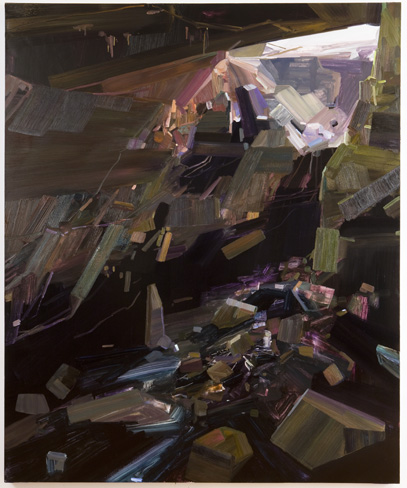
Claire Sherman, “Cave IV”
But, as a painter, when looking out that bedroom window at those rays grazing across the field, I was not enraptured by the idea of painting the scene of “what” was out there, but of painting the experience of looking out the window at that moment, at that split-second of seeing those colors and feeling them enter my bloodstream. At mixing those colors and seeing them side by side, even in an entirely abstract composition. I wanted to eat them, gorge myself on them, they looked so delicious.

Kevin Marc Bernstein, “Aggregation I”
This then made me think of a conversation I had not too long ago, when a scientist friend asked me to describe what I meant when I said that the basis of figurative painting is abstraction, and how exactly so. This question came up after discussing other painters, but was in reference to the way I paint also, which can appear less “abstract” certainly. I explained that, in order to appreciate art that is more or less abstract, one must have the eye that enjoys abstract forms, and this is a joy that is instinctual yet can be fostered. An abstract form is an isolated form with a certain size, shape, color, texture and edges that has no meaning other than its own qualities of size, shape, etc. However, this abstract form takes on meaning as soon as it is in the context of another abstract form; these amoeba-like forms build meaning through their juxtaposition. And an artist has control over how much attention they give to its qualities, and less control over how much they can actually see. The best part of painting – for me – is oozing around in this mode of seeing and gripping abstract shapes.
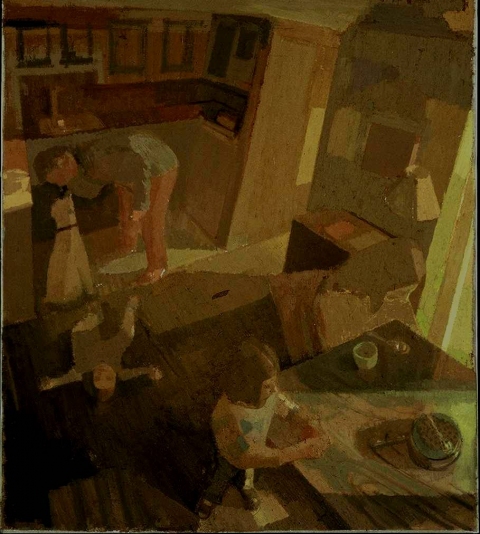
Susan Lichtman, “Winter Interior”
The meaning of forms can simply be a tension between them, or a dependent relationship within a composition which can affect the viewer, but it is always (in my opinion) a desire on the part of the artist to create a significant meaning, an “important” relationship of forms, which cannot be put into words, but is about the experience of human perception, of being there and being moved by this composition of elements. The artist can also, through the continued observation of the color, texture, edges etc of these forms, build an illusion which to our eyes appears 3 dimensional, and when this happens, the artist is particularly interested in giving new meaning to that figure/object/scene which appears. From a distance, the edges between these individual abstract forms can appear in varying degrees of hardness and softness, which have an effect on their appearance in space, in terms of what pops forward and what recedes. The color and value of these forms works the same way in this nature of observation/perception, in that light and warmth come closer to the eyes and dark and cool distance themselves. It all depends on how much the artist wishes to create the illusion of 3 dimensions, wishes to remain in the flatness of beautiful forms, or wishes to enrich one subgroup of what’s out there, for example the chroma, the edges or the tone.

Matt Klos, “Kitchen Window, Nightfall”
Perception is also an embedded element in figurative art. Everything out there can be seen as abstract forms, but perception is what allows for a human feeling to emerge related to them. Human beings are equipped with organs that allow perception, the sensing of light, color, warmth, dimension, texture and so forth. The process of looking at something or hearing something cannot always be separated from the feeling it gives. It is not only cold calculating of size, length and color mixing, for how would we explain goose bumps and shivers when hearing a story or thread of music. Our brain causes our skin and blood to react. These are perceptions that we cannot actually control, and so all of them are not only valid for inclusion, a true human painting cannot be created without them.

Daniel Enkaoua, “Le Melon et la Pasteque”
What makes figurative art based on abstraction and perception so difficult is that the parameters are so wide for inclusion and failure. Everything is open for observation, and everything is open for impending doom. Some artists focus purely on the forms that are out there, and others focus on a human concern to them. One can imitate, be repetitive, have good luck or bad, get stuck in reportage, overboard on feeling, lack a crucial element, have no important focus, or simply have nothing interesting to “say.” The artist can choose to not give a hoot about the qualities of the abstract forms and simply plop them down, or he can care to a great extent about every part of them. Great art can be said to cause the viewer to somehow become a better, more whole human being through an increased coming-to-grips with what might be out there and what might make this walk through life more valuable. By experiencing a scene made up of cared-for components, in a composition which provides non-verbal comfort, the viewer can soak up a small beauty in abstract, perceptual reality and therefore share in this visual awe about what real can be. A bit like having someone come in and remodel the entire backyard.
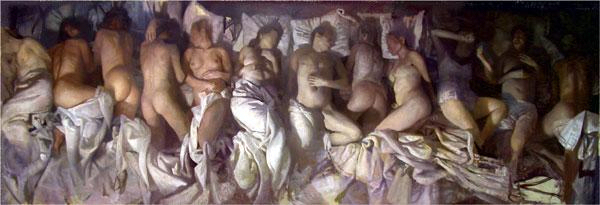
Vincent Desiderio, “Sleep”
But painters when painting are not usually thinking about the aftereffects of a possibly “successful” painting. When I get stuck about the “why” of painting, there is no one to give an answer, offer advice or provide comfort. No one is forcing me to pick up a paint brush. When I get stuck on the why, I think, and this might lead to new directions and explorations, so that the challenges change. But I turn to the works of others, especially new ones, like I look out the rear window: for a fresh rainfall of unexpected perspectives, a good douse of something that’s good for me amongst all the drivel.
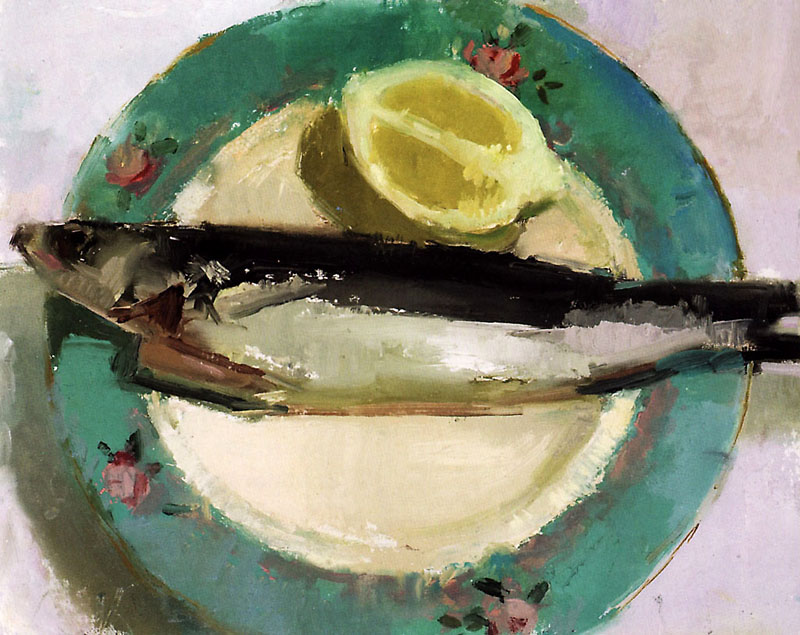
Eve Mansdorf, title unknown
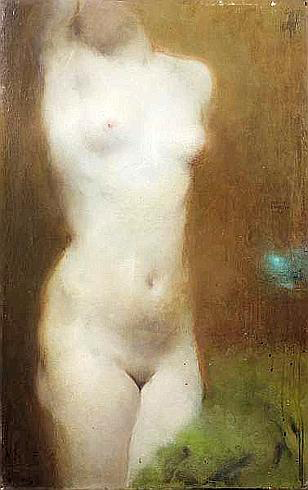
Thank you rebecca for sharing your thoughts about the enterprise of making images.
judith a
Judith – thank you! And thanks for the comments after the panel – hope you enjoyed it!
Rebecca
Thanks Rebecca! For a moment I was walking with you, listening to your conversation. As does your paintings, your conversation helped me to embrace the moments and
reach for an understanding. To get to the core of why,
and how, or at least scratch the surface of it.
I do understand though why I enjoy your paintings. Your
ability to communicate a human responce to your subject from your perspective is a “hug” from a beautiful universe.
Bill – I am honored to have such a thoughtful listener as you. Cheers to forging ahead in sincere perception!
Rebecca
beautiful. thanks for your thoughts.
Matt, thank you. I just looked over to your blog and found some incredibly beautiful things to spend some time with.
Rebeca,
I have gone back and read this last post over 4 times over 2 days. I wonder if you sound like the voice in my head.
“a desire on the part of the artist to create a significant meaning, an “important” relationship of forms, which cannot be put into words”
This is so much my truth. This is what really matters, far beyond any other concerns. I often wonder if some painters wouldn’t be better as writers they are so consumed with the verbal, the “literary”. In the end if the painting isn’t about communicating in the visual language, it must be a failure. The relationships of colors and tones and shapes, that’s enough, that’s all it needs to be.
Hi Steve,
Thanks for your encouragement and insight. Yes, sadly, there are many painters out there who are misled by what color and paint is about. Being too literary – or for that matter, too imitative of artists before – in painting is like repeating what someone else said just before them, and perfectly well. A literary painter might tend to go looking for a scene or composing one with all the “right things” and work days/months/years to get them all in, while a painter painter will walk down the street on his way to do something formidable like picking up the laundry but get stopped by chances to secretly communicate with some outrageous colors and light and shadows and…
A beautiful articulation of the tension in art between abstract form and meaning, and of the importance of getting to that place where sensation becomes “vision” – the “being there” that is so challenging in these frenetic times. Thanks!
Discovered this blog looking for commentary related to Vincent Desiderio’s “Sleep”— what incredible writing! Thanks so much for sharing your thoughts!